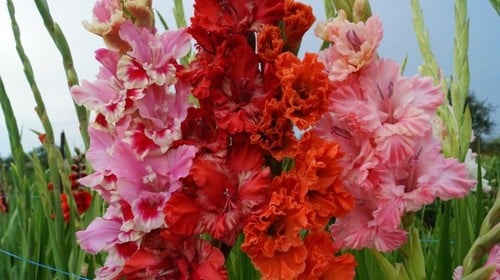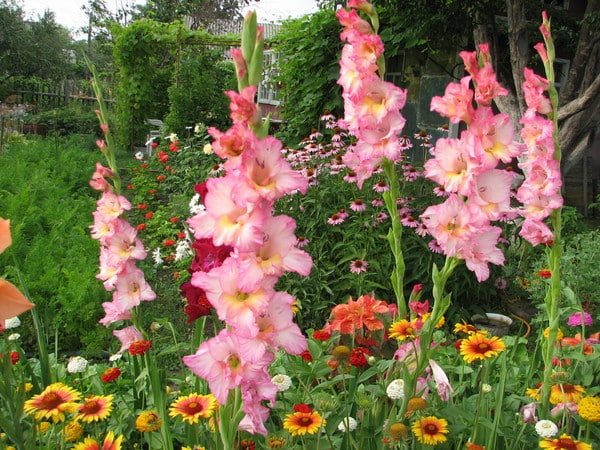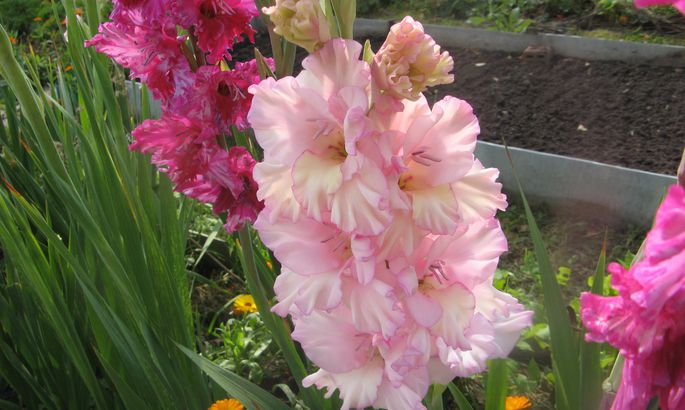Reasons why gladioli can change color and the effect of diseases on color
Why do gladioli gradually change color? This question worries many growers who grow this royal flower. If the plant propagated by seeds, then everything could be attributed to cross-pollination. But many gardeners breed gladioli with bulbs, and they must fully transfer the properties of the mother plant. What happens to the color scheme?
Possible reasons why gladiolus changes color
Oddly enough it sounds, but various diseases can be the reasons for the change in the color of gladioli. This conclusion was made by scientists after the research.
Fusarium
Fusarium is perhaps the most dangerous fungal disease of gladioli. It can be identified by the characteristic brown spots on the bulb. If such material is planted, then with a high probability it will not rise. Otherwise, the seedlings will bloom, after which they will dry out. Leaves on a diseased plant wither immediately. When an infected gladiolus bulb is placed in storage, the fungus will disperse the spores onto the healthy seed.
Sclerotinosis
This disease is popularly called black rot. It spreads well in acidic and dense soil, especially in cold rainy weather. The first sign of damage to gladiolus is brown foliage, after which the stem rots and falls off. On the affected plant, black areas are considered - agglomerations of fungi. The roots of the bulb change color to brown, after which they rot. Brown or dark brown spots are also visible on the planting material. There is no cure for this disease. Gradually, it is transferred to the formed daughter corms.

Botrythiasis
Florists call this disease gray rot. Damp and cold weather contributes to its spread. It was during this period that fungal spores are carried by wind and raindrops from affected gladioli to healthy ones.
Typical signs of the disease:
- Reddish spots become visible on the leaves of flowering plants.
- Flowers lose their decorative appearance, stems and corms begin to rot.
- When digging up, the bottom of the onion breaks or becomes soft.
Such planting material is subject to destruction. However, it is possible to collect healthy children with no signs of illness.

Septoriasis
Septoria is very similar in appearance to other fungal diseases. The spread of the disease is determined by the characteristic spots on the leaves, then the stem is affected. Gladioli cannot be cured.Affected bulbs must be destroyed.
Timely preventive measures are very effective in this case.
Bacterial scab
Pathogenic bacteria get on the bulbs of gladioli from the ground. The scab is characterized by erosion on the body of the planting material, but on the ground part of the flower, any changes are hardly noticeable. Near the soil itself, brown spots can be discerned on the leaves, which, without preventive and protective treatments, grow and destroy the flower.

Cancer
Root cancer is no less troublesome than fungi. Harmful bacteria invade the program of cells that are responsible for the formation of children. After digging up, you can easily see diseased bulbs with watery neoplasms. The disease cannot be treated, therefore it is necessary to carry out prevention on time, to get rid of nematodes.
Mosaic
Mosaic has become very popular only in recent years. Gardeners consider it a real misfortune. A characteristic sign of the disease is the alternation of light and dark spots on the leaves, which subsequently spread to the flowers. The disease negatively affects not only the decorative qualities of gladiolus, but also its growth. Flowers not only change color, but also become smaller, give fewer buds. At the same time, the bulb looks healthy outwardly. Timely preventive and protective treatments are required.

Do gladioli get pollinated?
It is believed that gladioli are not able to get dusty. Why? Because they are propagated by seeds only by breeders in order to obtain new varieties.
And when breeding with bulbs, the characteristics of the mother flower are fully transferred to the cub.
Of different varieties
Pollination does not threaten gladioli in private gardens, but they are still recommended to be planted according to varieties, in groups. They do this in order not to confuse the bulbs during storage and dig them out separately. After all, subsequently only the best and healthiest planting material will be selected, the rest will go to waste. As a result of such actions, only a couple of the most hardy and strong varieties remain in the garden. As a rule, they have low decorative qualities. The owner, on the other hand, has the impression that the flowers have become dusty and all of the same color.

Growing beside
When several varieties of gladioli are planted nearby, cross-pollination occurs without fail. But in order to observe the result obtained, you must first collect seeds from a flower, then grow corms from them, and only then they will delight the owner with a new unexpected riot of colors. This is a long and laborious process, which is why most gardeners propagate gladioli by separating bulbous babies. With this method, no cross-pollination of flowers is scary, even if many varieties with different characteristics are grown nearby.
Gladioli are beautiful and majestic plants. Their color scheme is simply amazing. So that they please the eye of the owner for a long period of time and do not change the withered varietal characteristics, the plants must be properly looked after, prevented from diseases and pests, ensure that the bulbs of cultivated varieties do not mix with each other during storage. Do not worry that your favorite flower will be pollinated from other gladioli if the gardener does not use the seed method of propagation and is not fond of selection.









